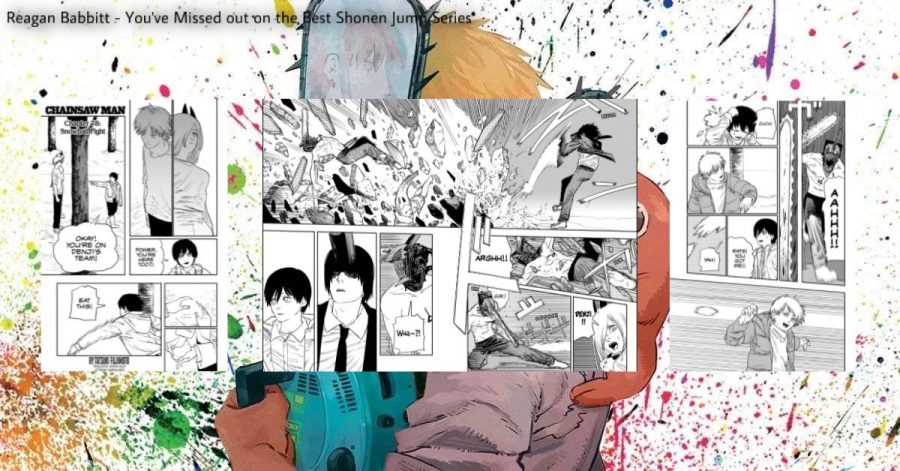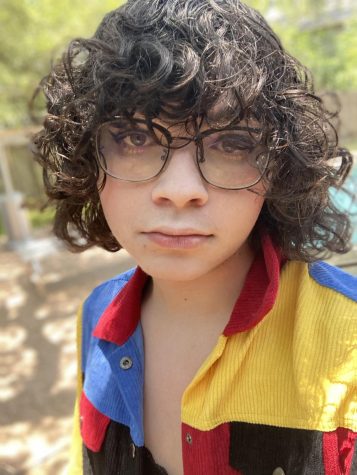You’ve Missed Out On the Best Shōnen Jump Series, ‘Chainsaw Man’
With his use of paneling and page-turns, Tatsuki Fujimoto manages to turn Chainsaw Man’s otherwise rough sketch-like character designs into an absolute thrill ride. The flow of these panels make for easy readability while also serving as an emotional highlight for the series. Photo courtesy of Tatsuki Fujimoto. Graphic by Reagan Babbitt.
September 27, 2021
In December 2018, mangaka (manga author and illustrator) Tatsuki Fujimoto began writing a title for Shueisha’s Weekly Shōnen Jump magazine. At the time, the title wasn’t too well-known in Japan or America, but eventually, readers who ended up finding the series would fall in love with it, resulting in the title ranking in at number five, Jump’s most popular magazine, right before ending in 2020. The title, known as Chainsaw Man, is now regarded as one of the most unique but also acclaimed series in Jump’s lineup. It would focus on a demon-infested dog-eat-dog world, subtle exploration and deconstruction of other Shōnen archetypes, and highlight brilliant yet purposefully flawed characters. While Chainsaw Man is regarded as unique—of which it certainly is at many points in the run of the series—a major part of the title is what I consider to be the most distilled Shōnen trait that almost all manga in Jump follow. It is ultimately Chainsaw Man’s narrative that gives it the impact that trait deserves.
Fujimoto’s Works:
Tatsuki Fujimoto is a very interesting man. While it’s one of his most well-known works, Chainsaw Man is far from his first outing as a writer. Starting with one-shots such as Sasaki-kun ga Juudan Tometa, Sasaki Has Stopped the Bullet, Koi wa Moumoku, and Love is Blind in 2013, he would later move on to series such as 2016-2018’s Fire Punch, a relentlessly grim series set in the now frozen-over Earth, featuring the protagonist Agni, who is constantly set on fire. In a similar vein to mangakas such as Akira Toriyama or Yoshihiro Togashi, Fujimoto continues to prove that many series from authors who had previous works and experience in the shōnen genre end up being some of the best, such as Toriyama’s Dragon Ball or Togashi’s Hunter x Hunter, and now Fujimoto’s Chainsaw Man.
The Story:
Despite being one of Jump’s top-selling manga since its 2018 serialization, Chainsaw Man is currently much shorter than any of the other recent long-running titles, spanning only 97 chapters and 11 volumes. Chainsaw Man, despite its slightly heavier and higher stakes, is a much shorter and contemporary story that focuses on the themes and characters. While it is confirmed at the end of Chapter 97 that the currently-released chapters are just the first arc of a larger story, Chapters 1-97 certainly feel like their own thing, even if the following chapters are a direct continuation of Chainsaw Man, like you would expect from most other shōnen titles.
Chainsaw Man has a much bleaker tone, more similar to stories such as Devilman as opposed to the most popular Jump titles. The story follows Denji, a poor young man who has spent his past years working for the yakuza, selling his body parts, and even hunting devils just for money, money that is immediately spent on the most basic needs. Denji lives with the Chainsaw Devil, Pochita, his only friend who unlike most devils, is merely a friendly dog with a chainsaw protruding from his head.
After being betrayed and killed by the yakuza, Denji and Pochita fuse to become Chainsaw Man, a fiend inhabiting Denji’s body giving him the ridiculous ability of, well, chainsaws that protrude from Denji’s arms, feet, and head. When Denji unleashes his new power, he is quickly discovered by the mysterious and somewhat terrifying Makima, who recruits normal people and other fiends like Denji to fight other devils. These recruited fiends range from shark-human hybrids, living poisonous gas, and literal angels. Denji meets the Blood Fiend, Power and the stoic but secretly emotional Aki, two people who seem hostile at first that he will later form an almost sibling-like bond with.
Denji and his co-workers are tasked with finding the Gun Devil, an incredibly powerful foe who wiped out half of the world in mere seconds. The catch is, Denji isn’t a hero. He certainly isn’t a villain, but he’s not combating the threats of these devils for any selfless reason. He’s in it purely for Makima, someone who realistically doesn’t really care about Denji. On Denji’s journey, he meets imperfect characters of whom, due to the dog-eat-dog nature of Chainsaw Man, may not see the story through the end. Eventually, the remaining devil hunters and fiends are met by the Gun Devil who after merging with Aki, becomes the Gun Fiend. Denji is forced to kill his new friend Aki for the sake of the world, his friend Power, and of course, Makima. The story ends with Denji forced to take on Makima, who is revealed to be the Control Devil, a terrifyingly powerful demon who after killing Power, forces Denji to fight all of the previous fiends, and a tease to the future of Chainsaw Man with Denji beginning his long-sought-after school life. Some of my favorite moments include Denji and Aki’s bonding time after defeating one of the powerful fiends because of how it forms this unlikely friendship in an unorthodox way. Denji’s time spent with Reze in school is among one of these poignant scenes as I remember just wanting these characters to be happy despite the soul-crushing truth that it won’t last. In addition, Denji watching people cheer for Chainsaw Man on TV at the tail end of the story resonates intensely because of its sheer irony. The story of Chainsaw Man and Denji’s character going from a person with no value to a delinquent with superficial goals, to a person who grows a soft spot for a couple of flawed people, and finally to a young man who loves his new family for who they are and would die for them is every bit as captivating as it is funny, terrifying, and soul-crushing.
Fujimoto’s Artwork:
While most outsiders see anime or manga art styles as somewhat realistic with exaggerated eyes, most shōnen series actually have a more cartoony style, including titles such as Dragon Ball, One Piece, or Hunter x Hunter. This is where Fujimoto’s art style differs. The art of Chainsaw Man is honestly pretty rough, almost as if Fujimoto was drawing humans from memory with some expressionist liberties. Chainsaw Man’s illustrations include some goofy and uncanny, but expressive faces, jagged linework, and extremely defined poses. The combination of those aspects and the well-structured paneling of the manga make the artwork feel like you’re in a museum looking at everything from paintings, to sculptures, to statues. While it isn’t exactly detailed, Fujimoto’s art manages to convey quick or heavy movement, human-like facial expressions, and brilliant panel-to-panel moments and page turns that make for easy readability.
This heart-pounding battle between Chainsaw Man and the Gun Fiend is punctuated by a metaphorical snowball fight between younger versions of Denji and Aki. In a movie, or in this case, an anime adaptation, simple editing tricks and cuts could transfer the impact of the traded blows between Denji and Aki through the impact of the snowballs thrown. In any comic, the authors don’t get the use of film editing. Fujimoto makes use of panel-to-panel artwork and similar poses between the starkly contrasted young Denji and Aki, Chainsaw Man, and the Gun Fiend, all while finishing it off with some frankly soul-crushing page turns that display the absolute carnage Aki unleashes on the people around. On top of that, the writing and facial expressions in both the snowball fight and the actual fight give a good sense of juxtaposition that remind the reader of the characters these two used to be, and what good friends they had become. The flaws in Chainsaw Man’s art can somehow reflect the flawed nature of all of these characters. Whether it was intentional or not, it’s most certainly an odd sense of beauty in this horrific series.
The Characters:
As I’ve said, the characters of Chainsaw Man are all purposely flawed. No shōnen character is perfect, but the cast of Chainsaw Man are more than just “not perfect.” This is evidenced by Denji’s aforementioned selfish reasoning for combating the Gun Devil, Power’s prejudice against humans in favor of demons, and Aki’s near inability to make bonds or find love and compassion in most people. It’s these flaws that make watching these characters crawl their way out of this proverbial hell so compelling. They’re human. It’s not uncommon to find people in the real world who aren’t perfect, so why can’t it be the same in Chainsaw Man? Denji as a protagonist is both a subversion and parody of shōnen protagonists, while also adhering to the core part of what makes those characters compelling. His extremely self-centered goals and teen attitude are a great juxtaposition to other characters such as Goku, Luffy, or Gon from other titles, but his journey of self-discovery and quite literally going from nothing to something is what I consider to be the most distilled part of any shōnen series and its characters. At a glance, Power might seem to be the side character meant to “steal the show,” and she certainly did, coming in first place with 35,268 votes in Jump’s Chainsaw Man popularity poll, but what makes Power so special is how she develops over the course of the series. Despite exhibiting prejudice against humans, Power finds genuine love and compassion for Denji, and even Aki, as she even ends up saving Denji after her death, when at the beginning of the story she would want and often end up betraying him. Aki is another character that looks simple at a glance. He may seem like the typical side character influenced by their past, but what’s interesting about Aki’s past is that it’s related to the main narrative and the Gun Devil, rather than an unrelated side-story. Aki at first doesn’t seem to care about Denji or Power despite having to live with them, and it’s implied that he doesn’t really care about anyone except for his close friend Himeno. It’s only when Aki loses someone that he ends up caring for the remaining people around him, which can be seen when it’s revealed that he’s still the only devil hunter who cries over his peers being killed. There are a lot of other great character moments, such as the reveal of Reze being a fiend, Makima’s increasing use of her unknown power, and almost every comedy moment involving Kobeni. Ultimately, I strongly believe that Fujimoto did his absolute best with the main trio.
Chainsaw Man is one of the best modern Jump series in the past years. It’s a very bleak story that often gives the reader something, be it a character or relationship just to snatch it away from them. While its future is uncertain concerning the lack of news for the second part of the story, fan speculation has gone wild and controversial, with news of the anime adaptation’s Studio MAPPA. I still value the 97 chapters Tatsuki Fujimoto has given us. It stood out amongst the other Jump titles that ran alongside it. It’s an absurd but mature story that somehow manages to make the reader laugh, only to make the reader cry. It’s a great series that many people have missed out on, but regardless of its popularity, we have Fujimoto for his crude art, his subversive writing style, and his brilliant characters.



